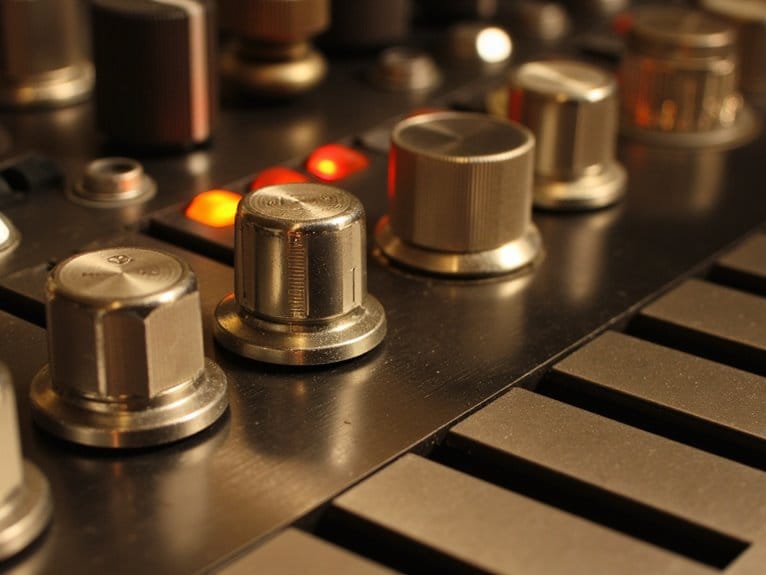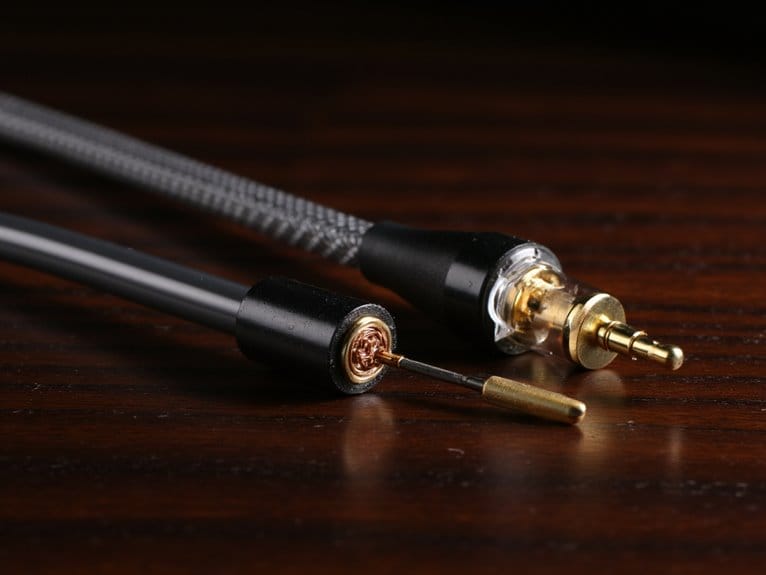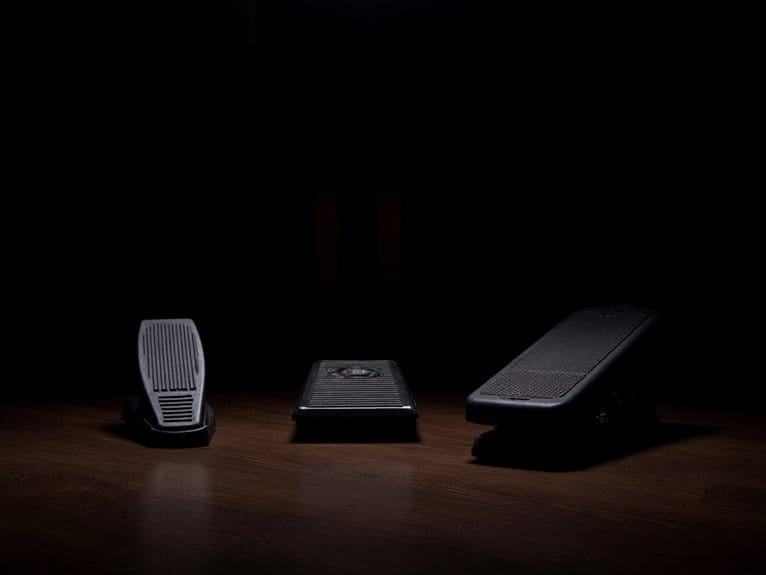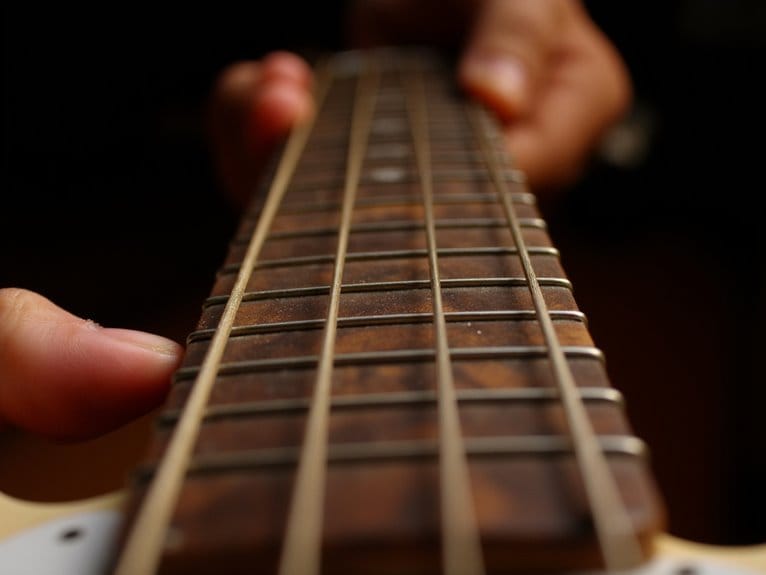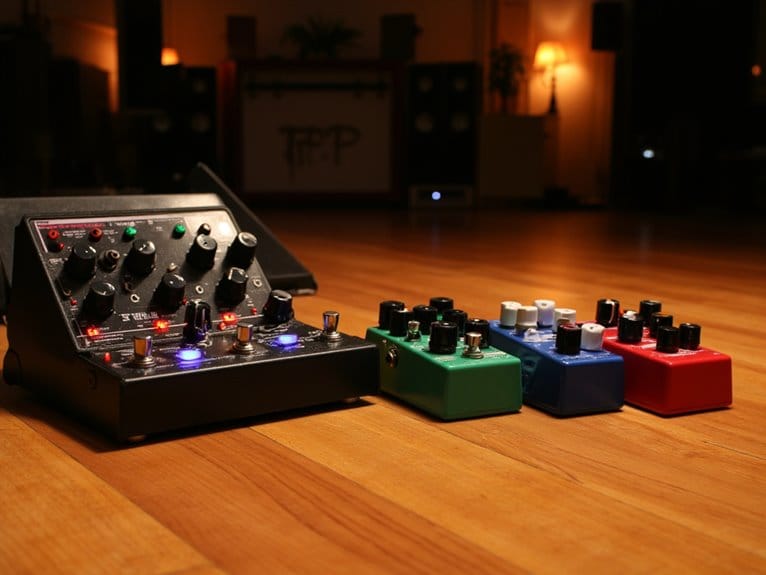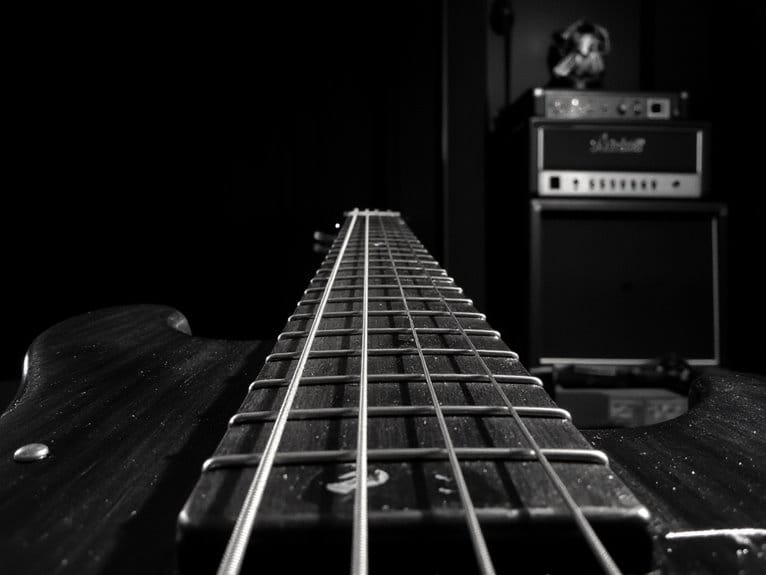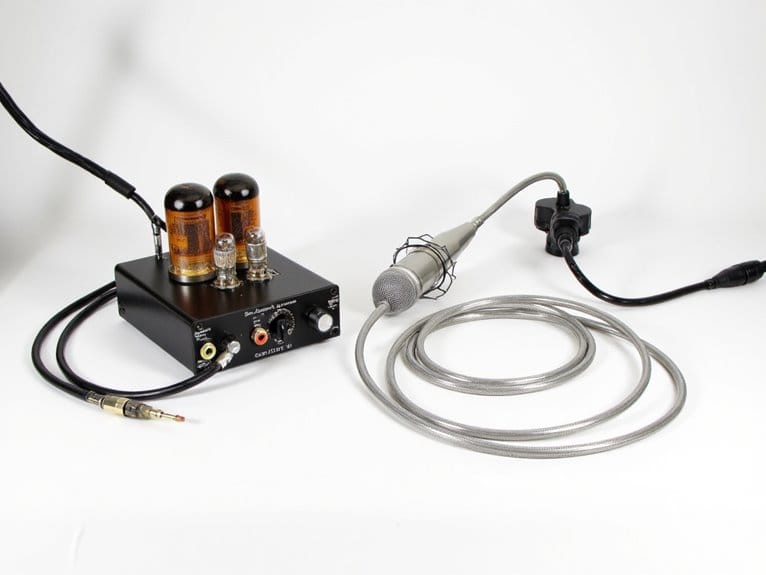Synthesizer LFOS and Modulation: Creating Movement in Sound
You’ll transform static synthesizer patches into dynamic, breathing sounds using Low Frequency Oscillators that modulate parameters like pitch, filter cutoff, and amplitude below 20 Hz. LFOs offer five essential waveforms—sine for smooth vibrato, triangle for precise modulation, square for rhythmic gating, sawtooth for sweeping effects, and random for experimental textures. Control rate, depth, and phase parameters to craft everything from subtle tremolo to dramatic pitch sweeps that defined electronic music since the 1960s Moog era, with advanced techniques awaiting your exploration.
We are supported by our audience. When you purchase through links on our site, we may earn an affiliate commission, at no extra cost for you. Learn more.
Notable Insights
- LFOs generate control signals below 20 Hz to automate parameter changes, creating vibrato, tremolo, and rhythmic effects without manual adjustments.
- Five primary waveforms offer distinct modulation characteristics: sine for smooth effects, square for rhythmic pulses, and random for chaotic textures.
- Rate controls modulation speed from glacial sweeps to tremolo effects, while depth determines intensity and phase sets starting positions.
- Advanced techniques include polyrhythmic modulation with multiple LFOs, envelope integration, and strategic routing through modulation matrices for complex textures.
- Strategic LFO implementation transforms static oscillators into memorable sounds by combining appropriate waveforms with tempo-synced rates and balanced modulation depths.
Understanding Low Frequency Oscillators and Their Role in Synthesis
When I first encountered LFOs in my early synthesizer experiments, I’ll admit I was puzzled by these seemingly invisible components that didn’t produce any audible sound on their own.
LFOs remained mysterious to me initially—these silent modulators that shaped sound without creating any audible output themselves.
These Low Frequency Oscillators operate below 20 Hz, generating control signals that modulate other synthesizer parameters rather than creating direct audio output.
The LFO Historical Significance traces back to 1960s Moog modulars, where accidental patch configurations first revealed their potential.
Modern LFO Hardware Variants have evolved from simple analog LFO Circuit Design using integrator/comparator circuits to sophisticated digital implementations.
Understanding their role reveals countless LFO Creative Uses, from basic vibrato and tremolo effects to complex rhythmic gating and dynamic filter sweeps that breathe life into static sounds. LFOs can generate various waveform types including sine, sawtooth, triangle, and square waves for different modulation characteristics. The primary advantage of LFOs is their ability to create automated changes to sound parameters, eliminating the need for constant manual adjustments during performance.
Exploring LFO Waveform Types and Their Unique Characteristics
Five distinct waveforms form the foundation of LFO modulation, and I’ve found that understanding their unique sonic fingerprints transforms how you’ll approach sound design entirely.
Sine waves deliver ocean-like smoothness for natural vibrato, while triangle waves offer more angular precision in LFO waveform comparisons. Square waves create binary on/off effects perfect for rhythmic pulsing, and sawtooth waves combine sharp rises with gradual falls for siren-like sweeps.
Random sample-and-hold patterns break predictable cycles with chaotic stepping. These LFO modulation effects become powerful tools when you match waveforms to specific genres—sine waves excel in ambient soundscapes, squares drive techno beats, and random patterns add experimental textures. Many synthesizers feature multiple oscillators to layer these waveforms and create even more complex modulation possibilities.
Mastering LFO wave manipulation and sound exploration through deliberate waveform selection opens countless LFO creativity tips and genre applications.
Essential Applications of LFO Modulation in Sound Design
When you’re working with LFOs in sound design, you’ll find that pitch and filter modulation create some of the most fundamental and recognizable effects in electronic music, from subtle vibrato that adds life to leads, to dramatic filter sweeps that define entire genres like house and techno.
I’ve discovered that amplitude modulation with LFOs produces everything from gentle tremolo effects that mimic vintage amplifiers, to aggressive rhythmic gating that can transform static pads into pulsing, tempo-synced elements that drive your tracks forward.
These core applications form the backbone of modern synthesis, where understanding how LFOs interact with oscillator pitch, filter cutoff frequencies, and amplitude levels gives you the tools to craft sounds that breathe, move, and evolve throughout your compositions.
Pitch and Filter Modulation
Modulating pitch and filter parameters with LFOs transforms static synthesizer sounds into dynamic, expressive instruments that breathe with musical life. When you apply LFO modulation to pitch, you’ll create everything from subtle vibrato that adds analog warmth to dramatic pitch sweeps that enhance atmospheric textures.
Filter modulation opens and closes cutoff frequencies cyclically, producing those classic wah-wah effects while contributing harmonic richness to your patches.
Strategic LFO applications include:
- Vibrato effects using sine wave modulation for natural pitch movement
- Filter sweeps with ramp waves creating siren-like timbral evolution
- Rhythmic complexity through tempo-synced LFO rates
- Step sequencing for deliberate pitch jumps and melodic interplay
- Random modulation generating unpredictable textures with digital clarity
Adjusting modulation depth and rate controls the intensity, from gentle movements to extreme sonic transformations. Modern FM synthesizers often feature motion sequence functions that can capture these real-time LFO parameter changes for more complex modulation patterns.
Amplitude and Rhythmic Effects
LFO amplitude modulation transforms your synthesizer into a rhythmic powerhouse, creating everything from gentle tremolo that adds vintage character to aggressive gating effects that slice through dense mixes with surgical precision.
You’ll discover that sine waves produce smooth tremolo textures, while square waves deliver sharp on/off volume changes perfect for rhythmic gating applications.
Tempo-synced LFOs align your amplitude effects with musical beats, creating sidechain-like pumping without actual compression, which proves invaluable in dance music production.
Slower modulation rates below 1 Hz generate breathing, pulsating effects that make static pads feel alive, while faster settings create stutter effects and polyrhythmic patterns.
The modulation depth parameter controls how dramatically your volume fluctuates, letting you dial in subtle shimmer or aggressive pumping that enhances groove and timing.
Advanced Techniques for Complex Modulation Patterns
Once you’ve mastered basic LFO applications, the real creative potential emerges when you start layering multiple modulation sources to build intricate, evolving soundscapes that breathe with organic complexity.
True artistry in sound design begins when layers of modulation dance together, creating patches that evolve and respond with lifelike spontaneity.
Advanced modulation techniques include:
- Polyrhythmic modulation using multiple LFOs at different frequencies to create shifting rhythmic patterns
- Dynamic textures through rate and depth modulation, where one LFO controls another’s parameters
- Modulation matrices enabling precise routing of sources to destinations with controllable amounts
- Envelope integration combining velocity-sensitive envelopes with LFOs for responsive, expressive articulation
- Frequency modulation utilizing complex oscillators for cross-modulation and evolving harmonic content
These multi-layered approaches transform static patches into living, breathing instruments that respond organically to your playing style.
Mastering LFO Control Parameters for Precise Sound Shaping
Understanding the fundamental control parameters of your LFO transforms what might seem like random oscillation into precision sound sculpting, and I’ve found that mastering these core elements separates amateur tinkering from professional sound design.
You’ll discover that rate determines the rhythmic foundation of your modulation, depth controls the dramatic intensity of parameter movement, and phase relationships create the subtle timing nuances that give your patches their unique character.
These three pillars work together to form the backbone of expressive synthesis, where small adjustments in each parameter can dramatically reshape your sound’s evolution, movement, and overall sonic personality.
Rate and Speed Control
Three fundamental parameters shape every LFO’s behavior, but rate control stands as the most immediately impactful, determining whether your modulation crawls like a lazy sunrise or races like a hummingbird’s wings.
Rate experimentation reveals LFO modulation’s full potential, spanning from 0.01 Hz glacial sweeps to 20 Hz tremolo effects.
Creative automation becomes possible when you modulate the rate parameter itself, creating movement evolution that transforms static patches into dynamic soundscapes.
Syncing strategies offer two distinct approaches:
- Tempo-locked divisions (quarter notes, eighths, sixteenths) for rhythmic diversity
- Free-running rates for polyrhythmic textures independent from your project’s grid
- Rate ramping techniques that accelerate or decelerate modulation over time
- Modulation layering using multiple LFOs at different speeds
- Expressive controls through external devices controlling rate parameters
Understanding these rate fundamentals transforms simple oscillation into sophisticated sound design tools.
Depth and Amount Settings
While rate determines how fast your LFO oscillates, depth controls how far it travels during each cycle, fundamentally governing the intensity of modulation applied to your target parameter.
Think of depth modulation as your volume knob for movement—zero depth means no effect, while maximum settings create dramatic expressive effects that can completely transform your sound’s character.
I’ve found that mastering depth control requires balancing subtle dynamics with sonic clarity, especially when layering LFOs across multiple elements.
Lower settings preserve your original tone while adding gentle texture, whereas higher values produce creative modulation that borders on the extreme.
Smart depth automation creates dynamic shifts throughout your performance, and understanding modulation responsiveness helps you craft everything from whisper-quiet vibrato to filter sweeps that’ll make listeners question reality.
Phase and Sync Options
Beyond controlling how much your LFO moves, you’ll need to master where that movement begins and how it stays locked to your musical timing, which brings us into the precision domain of phase and sync controls.
Phase modulation determines your LFO’s starting position within its cycle, while reset behavior controls whether each note triggers a fresh cycle or continues the ongoing pattern. Tempo syncing locks your LFO to external MIDI clock for rhythmic consistency.
- Phase Position: Set initial cycle offsets (0, 1/4, 1/2, 3/4) for timing accuracy
- Key Trigger: Toggle between per-note reset or continuous background operation
- Polyphonic Control: Independent phase states per voice for expressivity enhancement
- Sync Options: Global versus per-voice LFO synchronization settings
- Reset Frequency: Choose between every note or selective triggering patterns
Modern synthesizers with higher polyphony counts enable more complex modulation patterns across multiple voices simultaneously. Professional instruments with dual LFOs provide additional modulation routing possibilities and enhanced sound design flexibility. Proper configuration prevents phase drift and maintains modulation clarity throughout complex performances.
Creating Dynamic Movement and Evolving Textures
When you’re crafting evolving textures with synthesizers, the secret lies in harnessing LFOs to breathe life into what would otherwise be static sounds. Through strategic modulation layers, you’ll transform basic pads into dynamic, breathing compositions that shift continuously throughout their duration.
| LFO Target | Waveform | Effect |
|---|---|---|
| Filter Cutoff | Sine | Smooth brightness sweeps |
| Wavetable Position | Triangle | Linear timbral shifts |
| Oscillator Pitch | Random | Chaotic texture variation |
The real magic happens when you layer multiple LFOs operating at different speeds, each targeting separate parameters like amplitude, filter frequency, and wavetable positions. This creates sound evolution that feels organic rather than mechanical, with slow sine waves providing gentle movement while random waveforms introduce unpredictable elements that keep listeners engaged throughout extended passages. When recording these evolving textures, ensure your audio mixer provides USB connectivity for seamless capture of your modulated synthesizer performances directly to your digital audio workstation. Recording in spaces with poor acoustics can benefit from using microphones with excellent noise rejection to minimize unwanted ambient sound during synthesis sessions. For budget-conscious producers, affordable interfaces with 48V phantom power enable professional recordings of external synthesizers alongside condenser microphones in the same session.
Building Iconic Synth Sounds Through Strategic LFO Implementation
Since I’ve spent countless hours programming synthesizers and analyzing classic tracks, I can tell you that iconic synth sounds aren’t accidents—they’re the result of deliberate LFO routing decisions that transform basic oscillators into memorable musical statements.
Building these iconic textures requires strategic thinking about which parameters receive LFO modulation and how deeply they’re affected. Creative layering of multiple LFOs creates sound evolution that keeps listeners engaged, while careful modulation depth adjustments prevent overwhelming the mix.
- Route sine wave LFOs to filter cutoff for smooth, classic sweeps
- Apply square wave modulation to amplitude for rhythmic gating effects
- Use sawtooth LFOs on pitch for aggressive acid bassline character
- Sync LFO rates to tempo for cohesive rhythmic creativity
- Combine random waveforms with traditional shapes for sonic experimentation
Performance expressiveness emerges when you balance predictable modulation with unexpected textural variations.
Frequently Asked Questions
Can LFOS Be Synced to External MIDI Clock or DAW Tempo?
You can absolutely sync LFOs to external MIDI clock or DAW tempo through proper LFO clocking settings. Many synthesizers offer MIDI sync modes that’ll lock your modulation timing perfectly with external sequencers and software.
What’s the Difference Between Bipolar and Unipolar LFO Modulation?
Bipolar modulation swings both above and below zero volts, creating symmetrical movement around a center point. Unipolar modulation only moves in one direction from zero, never crossing into negative voltages for single-direction effects.
How Do I Prevent LFO Modulation From Making My Sound Out of Tune?
You’ll want to reduce your LFO’s modulation depth to keep pitch variations subtle. Use LFO scaling techniques to control the amount, and make tuning reference adjustments by avoiding direct frequency modulation on your oscillators.
Can I Use Audio-Rate Frequencies as LFOS for Special Effects?
You can definitely use audio-rate frequencies as LFOs for special effects. Audio rate effects create metallic tones, FM-style sounds, and complex timbres. Pitch modulation at these speeds produces bell-like textures and harmonically rich results.
On a final note
You’ve now got the foundation to transform static sounds into living, breathing compositions through strategic LFO implementation. Start with simple rate and depth adjustments on basic waveforms, then gradually experiment with complex routing and multiple modulation sources. Remember, subtlety often creates more musical results than extreme settings. Don’t be afraid to automate your LFO parameters throughout your tracks—that’s where the real magic happens in modern synthesis.

